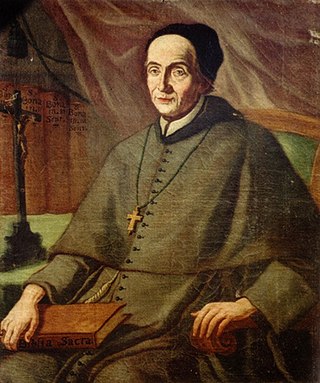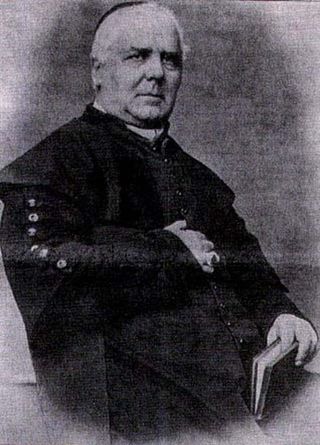Related Research Articles

Antonio Lucci, born Angelo Nicola Lucci, was an Italian Roman Catholic professed member from the Order of Friars Minor Conventual and served as the Bishop of Bovino from 1729 until his death.

Cándida María de Jesús, born Juana Josefa Cipitria y Barriola, was a Spanish nun and the founder of the Daughters of Jesus. The order – founded in 1871 – was under Jesuit direction from her spiritual director and was involved with the education of children in Salamanca though expanded during her lifetime.

Jacques-Désiré Laval was a French Roman Catholic priest who served in the missions in Mauritius; he was a professed member from the Spiritans. He is known as the "Apostle of Mauritius" due to his tireless work in aiding the poor and ill. Laval also educated the flock he was assigned to for those people were uneducated and were former slaves for the most part. His skills in medicine made him a distinguished figure in the region since his expertise allowed him to tend to those who suffered illness that manifested more so during times of an epidemic.

Rafaela Ybarra Arambarri de Vilallonga is a Spanish Roman Catholic widow and the founder of the Sisters of the Holy Guardian Angels. Vilallonga was part of Bilbao's upper-class and she mothered seven children with her husband José Vilallonga.

Bolesława Maria Lament was a Polish Roman Catholic professed religious and the founder of the Missionary Sisters of the Holy Family. Lament worked as a seamstress and soon joined a religious order though left just prior to her profession upon experiencing vocational doubts; she returned to her life as a seamstress and worked with two of her sisters to support their siblings and widowed mother. The death of her seminarian brother prompted her to return to the religious life - Honorat Koźmiński encouraged this return - and she later founded an order that soon spread and took her to Russia though its revolution forced her departure during World War I.

Maria Domenica Mantovani was an Italian Roman Catholic professed religious, and the co-founder of the Little Sisters of the Holy Family; she established them alongside Giuseppe Nascimbeni. As a nun she received the religious name of Maria of the Immaculate.

María Guadalupe García Zavala – born Anastasia Guadalupe García Zavala – was a Mexican Roman Catholic religious sister and the co-founder of the Handmaids of Santa Margherita and the Poor. She is also known as "Mother Lupita". At one time, she was engaged to be married but she decided her religious call was too strong for that and she broke off her engagement in order to pursue this call. She dedicated herself to the care of ill people and was noted for her compassion and faith.

Luigi Maria Monti was an Italian Roman Catholic professed religious and the founder of the Sons of the Immaculate Conception. He was referred to as "Father" despite not being an ordained priest. Monti served as a nurse for most of his life and aided the ill in the Santo Spirito hospital in Rome while he was there and also worked to tend to ill people during the Brescia cholera epidemic in 1855. Monti also considered entering the religious life and joined the order of Lodovico Pavoni for a brief period of time though became a religious of his own order later on.
Francesco Antonio Marcucci was a Roman Catholic Italian bishop and a member of the Secular Franciscan Order. Marcucci was also the founder of the Pious Workers of Mary Immaculate.

María López de Rivas Martínez, religious name María of Jesus was a Spanish Discalced Carmelite. She was beatified on 14 November 1976 and her cause for sainthood continues.

Blessed Costanza Starace was an Italian Roman Catholic nun. She was the founder of the religious congregation known as the Compassionist Sisters Servants of Mary. Starace later assumed the new name of "Maria Maddalena of the Passion" upon the occasion of her solemn profession. She became a secular member of the Servite Order after she failed to join a religious order.

María Dolores Rodríguez Sopeña was a Spanish Roman Catholic nun and the founder of the Sisters of the Catechetical Institute. Her religious activism came about from her earliest experiences in Almería where she tended to the poor including a leper though she later moved to Madrid and Puerto Rico where she continued her care for the poor and the sick. Her return to her native land saw her continue her work and her commitment to establishing religious and secular movements for others all directed towards active participation and care for poor people.
Vicente Vilar David was a Spanish engineer from Spain at the time of the Spanish Civil War in the 1930s during a period of intense anti-clerical sentiment. As a worker he strove to adhere to the social doctrine of the Christian faith and spread such values in the workplace and among his colleagues. He was killed on the basis of aiding priests and religious escape the persecution by the Republicans during the Civil War.

Gertrude Prosperi was an Italian nun of the Order of Saint Benedict. Prosperi - upon her profession into the Benedictines - assumed the religious name Maria Luisa Angelica and finally served as the abbess of her convent for an extended period of time until her death.
Giuseppe Oddi was an Italian Roman Catholic professed religious - though not a priest - of the Franciscan Order of Friars Minor. He felt drawn to religious life after his adolescence and was resolved to become a Franciscan upon seeing the example that Mariano da Roccacasale set. Upon his profession of vows he assumed the religious name of "Diego from Vallinfreda".

Zefirino Agostini was an Italian Roman Catholic priest that served in his hometown of Verona to perform his pastoral duties. He established two religious congregations in his lifetime being the Pious Union of Sisters Devoted to Saint Angela Merici and the Ursuline Sisters of the Daughters of Mary Immaculate.

Blessed Luigi Monza was an Italian Roman Catholic priest and the founder of the Secular Institute of the Little Apostles of Charity. Monza's pastoral mission was defined with catering to the needs of the poor and the sick and used his new congregation as a means of spreading this mission.

María del Tránsito Cabanillas was an Argentine Roman Catholic Franciscan tertiary and the founder of the Franciscan Tertiary Missionary Sisters. Upon her solemn profession she assumed the religious name María del Tránsito de Jesús Sacramentado. Cabanillas was beatified on 14 April 2002.

Pietro Bonilli was an Italian Roman Catholic priest and the founder of the Sisters of the Holy Family of Spoleto. Bonilli served as a diocesan priest for his entire life in both Trevi and Spoleto while using his order to reach out to orphans and homeless people.

Maria Ripamonti, also known by her religious name Lucia dell'Immacolata, was an Italian Roman Catholic and a professed religious from the Ancelle della carità. Ripamonti worked at a spinning mill before leaving her hometown in 1932 for Brescia to enter a religious congregation after having met a visiting nun in her hometown. In 1938 she made her perpetual profession and started residing in the order's motherhouse in Brescia and was later diagnosed late with a serious illness that led to her death in 1954.